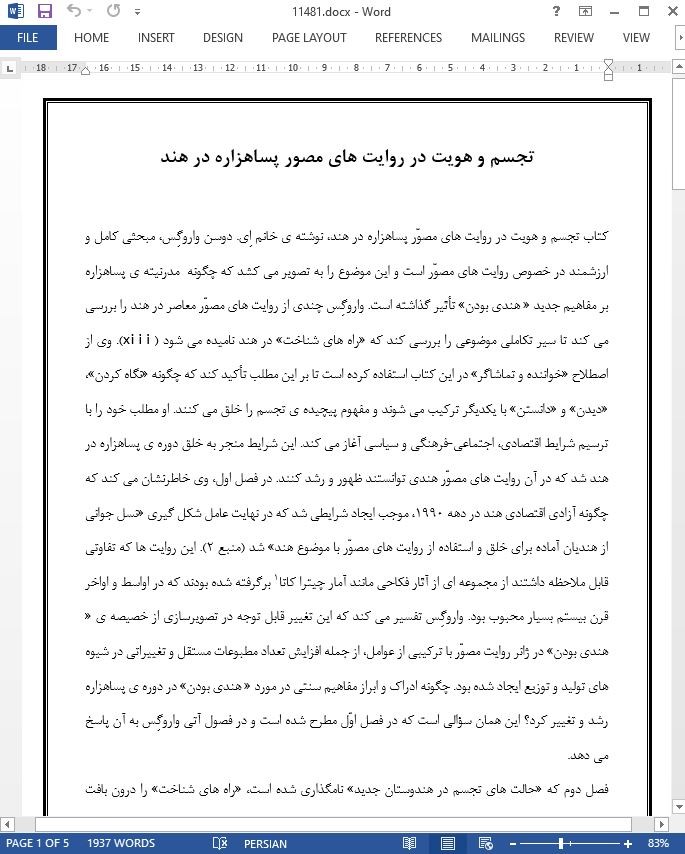
تجسم و هویت در روایت های مصور پساهزاره در هند
کتاب تجسم و هویت در روایت های مصوّر پساهزاره در هند، نوشته ی خانم اِی. دوسن واروگِس، مبحثی کامل و ارزشمند در خصوص روایت های مصوّر است و این موضوع را به تصویر می کشد که چگونه مدرنیته ی پساهزاره بر مفاهیم جدید « هندی بودن» تأثیر گذاشته است. واروگِس چندی از روایت های مصوّر معاصر در هند را بررسی می کند تا سیر تکاملی موضوعی را بررسی کند که «راه های شناخت» در هند نامیده می شود (xiii). وی از اصطلاح «خواننده و تماشاگر» در این کتاب استفاده کرده است تا بر این مطلب تأکید کند که چگونه «نگاه کردن»، «دیدن» و «دانستن» با یکدیگر ترکیب می شوند و مفهوم پیچیده ی تجسم را خلق می کنند. او مطلب خود را با ترسیم شرایط اقتصادی، اجتماعی-فرهنگی و سیاسی آغاز می کند. این شرایط منجر به خلق دوره ی پساهزاره در هند شد که در آن روایت های مصوّر هندی توانستند ظهور و رشد کنند. در فصل اول، وی خاطرنشان می کند که چگونه آزادی اقتصادی هند در دهه 1990، موجب ایجاد شرایطی شد که در نهایت عامل شکل گیری «نسل جوانی از هندیان آماده برای خلق و استفاده از روایت های مصوّر با موضوع هند» شد (منبع 2). این روایت ها که تفاوتی قابل ملاحظه داشتند از مجموعه ای از آثار فکاحی مانند آمار چیترا کاتا برگرفته شده بودند که در اواسط و اواخر قرن بیستم بسیار محبوب بود. واروگِس تفسیر می کند که این تغییر قابل توجه در تصویرسازی از خصیصه ی « هندی بودن» در ژانر روایت مصوّر با ترکیبی از عوامل، از جمله افزایش تعداد مطبوعات مستقل و تغییراتی در شیوه های تولید و توزیع ایجاد شده بود. چگونه ادراک و ابراز مفاهیم سنتی در مورد « هندی بودن» در دوره ی پساهزاره رشد و تغییر کرد؟ این همان سؤالی است که در فصل اوّل مطرح شده است و در فصول آتی واروگِس به آن پاسخ می دهد.
Visuality and Identity in Post-Millennial Indian Graphic Narratives (2018) by E. Dawson Varughese is a valuable exploration of graphic narratives that portray how post-millennial modernity has influenced new conceptualizations of “Indianness.” Varughese analyzes a number of contemporary Indian graphic narratives in order to trace the significant evolution of what she refers to as Indian “ways of seeing” (xiii). Throughout the book, she employs the term “reader-gazer” to emphasize how “looking,” “seeing,” and “knowing” all come together to create a complex notion of visuality. She begins by outlining the economic, socio-cultural, and political conditions that led to the creation of the postmillennial Indian moment in which the Indian graphic narrative was able to emerge and thrive. In the first chapter, she notes how the economic liberalization of India in the 1990s generated conditions that were eventually responsible for the formation of a “generation of ‘young’ Indians ready to both consume and create Indian-oriented graphic narratives” (2). These narratives were marked by their striking difference from comics such as Amar Chitra Katha, which had been extremely popular throughout the mid and late twentieth century. Varughese construes that this remarkable change in the portrayal of “Indianness” in the graphic narrative genre was caused by a combination of factors, including the growth in the number of independent presses and the shifts in production and distribution techniques. How did the perception and representation of traditional notions about “Indianness” change and evolve in the post-millennial moment? This is the question, posed in the first chapter, which she answers in the following chapters.
- اصل مقاله انگلیسی با فرمت ورد (word) با قابلیت ویرایش
- ترجمه فارسی مقاله با فرمت ورد (word) با قابلیت ویرایش، بدون آرم سایت ای ترجمه
- ترجمه فارسی مقاله با فرمت pdf، بدون آرم سایت ای ترجمه

